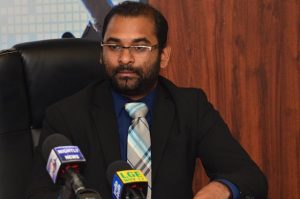– GCAA says
REPRESENTATIVES of the Guyana Civil Aviation Authority (GCAA) have noted that Phase Two of Guyana’s air travel re-opening plan could come by August 28, 2020.
This information was presented by GCAA Director of Aviation Safety and Security, Abraham Doris during the first round of the Tourism Recovery Action Committee (TRAC)’s stakeholder consultations hosted Online on Thursday.
He was accompanied by Director of Air Transport Management Saheed Sulaman, and as part of a presentation, the two discussed circumstances likely to influence travel to Guyana in the near future and the measures implemented by local airports to prevent the spread of COVID-19 when scheduled flights return.

Doris said that with Phase One of the government’s reopening plan ongoing, Phase Two is tentatively estimated for August 28, and will facilitate limited incoming flights from citizens, permanent residents, international workers and diplomats. Meanwhile, Phase Three could come by September 30, and will include limited flights and flights open to foreign nationals. The final phase, Phase Four, will include the removal of travel restrictions on various states.
It was noted that the restart date of airline operations in Guyana is contingent on the re-opening of Guyana’s airports. Eastern Airlines has already made itself available for repatriation flights, and will extend its services upon the reopening of Guyana’s airports. Aruba Airlines should be available between August to December, while Jet Blue will be available in Spring of 2021. Caribbean Airlines, Suriname Airways, American Airlines and Copa Airlines are still to provide advice on their operations, and for LIAT, due to its challenges, restart remains uncertain.
Sulaman said that Guyana is classified as an Origin and Destination Market, which sees the country having five main hubs out of Georgetown. They are Panama, Miami, New York, Port of Spain and Barbados. He said Guyana is monitoring the situation in these countries closely, as that’s where most of its flights originate from.
“We found that not many airlines are interested in operating in Phase Two. Phase Two has to do with the transport of citizens of Guyana, permanent residents living in Guyana, international workers and diplomats. Most airlines are interested in Phase Three, when the foreigners are allowed to fly. We’re waiting on airlines to say when they would want to participate once we reopen, but for Phase Two, only one airline would have indicated their interest in participating,” Sulaman said.
STRICT MEASURES IN PLACE
In reopening airports and resuming aircraft operations, the GCAA must focus on regulating aviation safety and security; advocating safety and hygiene practices; promoting safe aviation environments and safer travel; and facilitating tourism in Guyana.
During the month of June and into July, as part of Phase One of its reopening plan, the GCAA and Ministry of Public Health (MoPH) have conducted several walk-throughs at the airports, and conducted extensive research on international best practices in dealing with COVID-19.
The Authority has mapped the processing of passengers from the time they check-in to departure, or from the time they arrive, and has developed a set of Standard Operations Procedures (SOPs) that are already being used during the repatriation of Guyanese.
The SOPs apply to both the airports and aircraft operators; airport and airline personnel; port health workers; and customs and immigration. Ultimately, they establish safety and hygiene practices for passengers and employees.
For example, for entry to airport travel, persons are subject to temperature testing, disinfection of baggage, hand sanitization, the wearing of masks, physical distancing and more.
Within the CJIA itself, there are social- distancing markers on the floors and seats; trolleys and carts are cleaned regularly; the floors are sanitised frequently; and there are several hand sanitising stations.
“These are all in an effort to ensure that the airports remain COVID-free, or to at least mitigate the spread of COVID to the extent that is practicable,” Doris said, adding that similar measures have been implemented at the Eugene F. Correia International Airport at Ogle.
For small aircraft operators, apart from the foregoing measures, others have been implemented to ensure 50 per cent capacity; the sanitisation of baggage and cargo; and the wearing of protective gear on board the aircraft.
Doris said that Safety and Security Inspectors of the Civil Aviation Authority are conducting frequent surveillance of airports and aircraft operations for compliance with a checklist of SOPs and the necessary regulations.



.jpg)








